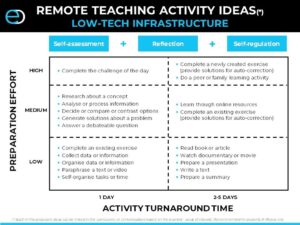Remote teaching in a “low-tech” environment
At the same time that the world is suffering from the coronavirus outbreak, certain other events are being triggered. In response to the crisis, different governments are ordering nationwide school closures as an emergency measure to prevent the spreading of the infection. This decision is having many consequences, and it can also be considered as a catalyst for education innovation. Like all innovations, it brings the challenge of doing things differently and the exciting potential of doing different things.
The opportunity is here.
Nobody can deny that technology helps us become more productive if used properly. This fact also applies to a school environment. However, the current technology infrastructure at most of the schools was designed for teaching and learning approaches that are becoming obsolete.
It is in this “low-tech” environment, where computer use for learning is restricted to certain times of the day, and there is little if any video infrastructure available, where a big opportunity arises.
Under these circumstances, trying to replicate the current approaches to teaching in a remote setting results in an increase of disappointment and discouragement for teachers, students, and parents. We need a paradigm shift in the way we think about the learning process.
The status quo is not an option.
After many discussions with teachers that are doing their best in an unknown and complex environment, making massive efforts to create online training materials and deliver them through the internet in record time, at Edunexis we have put together some activity ideas (see table below) that can be used as alternative approaches to teaching during the time that the school is closed and beyond.
The underlying foundation of any of the proposed activities is that the role of a teacher shifts to being more of a coach and helper of the learner strategies, and the role of the learner shifts to being more active and self-directed.

The activities can be completed following a stand-alone format (e.g. research about pandemic threats) or connected format (e.g. research, followed by an analysis of the information, followed by the generation of potential solutions).
To provide additional information to the teachers, the activities have been categorised in terms of preparation effort by the teacher and activity turnaround time by the student. This classification is only indicative, and it can vary depending on the scope of the activity defined by the teacher.
Scaffolded reflection closes the learning loop.
Scaffolded reflection is one of the strategies that can help students increase their self-awareness and learn quicker than they would with traditional instruction. To complete the activity, we strongly suggest the teacher to prompt students to self-assess the outcome of their effort, followed by a series of reflection questions, and potentially the request to identify an action to self-regulate their learning process.
Students must transition towards taking more responsibility in their development.
To survive and thrive in a world of change, we need to develop learners who can effectively and creatively apply skills to new situations. The learning centre of gravity must move from the content learning towards the learning process.
Today’s context provides a great opportunity to stimulate self-determined and self-directed learning approaches, and to trigger the transition of the students towards taking a bigger role in their learning process.
Additional resources.
If you need additional ideas or resources regarding how to develop this great opportunity further, you can contact us at [email protected].



